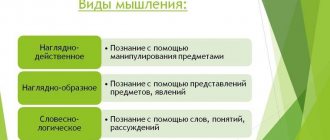Thinking and speech are closely related to each other, however, they cannot be called unequivocally one and the same. It also cannot be said that one stems from the other, but one should not deny the connection between thinking and speech. Speech has its own tools for managing it, called grammar, while thinking operates with logic and logical concepts. Logic and grammar are completely different tools that perform completely different functions. They cannot be equated to each other from any point of view. In addition to the above, it is worth noting that although speech and thinking historically helped each other develop, they still occurred separately and initially performed different functions in human life.
The role of speech in the thought process
Speech plays a huge role in the thinking process. A thought in the human head always appears in verbal form, even if for some reason the person is unable to speak in its usual form. This is possible if, for example, a person is deaf and dumb or did not grow up among people - in this case, gestures or emerging mental images will be used as speech, they will play the role of words.
Are you an expert in this subject area? We invite you to become the author of the Directory Working Conditions
The beginning of the thought process is a question or the formation of a problem that needs to be solved. Then a certain thought is born, which is only a general preparation, and in the process of processing by the brain it turns into something more integral and with structure.
Definition 1
The process of putting thoughts into some initial verbal form is called inner speech.
It is with the help of inner speech that preparation takes place to put the general idea into words in the form of oral or written speech. At the stage of internal dialogue, a thought is processed to form subsequent meaningful phrases and sentences from it using all kinds of grammar constructions; this process can be compared to the compilation of code in programming - what was initially just a kind of representation, a thought form, turns into a harmonious series with the help of words, phrases and then sentences. The Soviet psychologist Vygotsky described this phenomenon as follows: “thought is accomplished in the word.”
Finished works on a similar topic
Course work The relationship between thinking and speech 430 ₽ Essay The relationship between thinking and speech 270 ₽ Examination The relationship between thinking and speech 210 ₽
Receive completed work or specialist advice on your educational project Find out the cost
Despite the information presented above, you should not equate the concept of “speech” with the concept of “thinking” - one may well exist without the other, although they are closely interrelated. This is easy to verify: any thought can be expressed using various speech constructions and thereby prove the inconsistency of such an equation. Also quite illustrative are those cases when a person has some kind of thought, but he cannot express it in a verbal form that is accessible and understandable to everyone, or he can, but the meaning is partially lost or distorted.
Speech is characterized by obsolescence, but this is not typical of thinking. The thought may be the same, but depending on what era or even environment a person is in, he will choose different words to express it. Moreover, this will also apply to internal speech; it also cannot be equated with thinking, because at different times we can remember the same thought in different ways, or, conversely, forget the thought and remember only an incomplete verbal formulation, which cannot fully help restore the essence of the original idea. However, in general, a person remembers a thought better than its verbal description.
Speech is the external psyche of the subject and, accordingly, one of the most important psychological functions, giving a person the opportunity to be understood by others. Speech translates mental phenomena into an observable process. And vice versa, in the case of understanding spoken speech, such a process turns into a thought, a psychological product. The question of the connection between speech and thinking is, in a certain sense, key in the psychology of speech. It is obvious that normal speech is certainly meaningful, since its main function is to express meaning. At the same time, the forms of connection between thought and word are difficult to imagine. Researchers identify three main functions of speech: communicative, regulating and programming.
1. The communicative function of speech ensures communication between people using language.
Language is a system of verbal signs, a means by which communication between people is carried out. Speech is the process of using language to communicate between people. Speech is not so much communication during work as communication for work. speech is one of the means that constructs this activity. Speech is essentially not the business of an individual, not the business of an isolated native speaker: it is, first of all, the internal activity of society, carried out by it through individual native speakers or, more precisely, with their help.
The system of verbal symbols expands the possibilities of a person’s adaptation to the environment, the possibility of his orientation in the natural and social world. Through the knowledge accumulated by humanity and recorded in oral and written speech, a person is connected with the past and the future. The human ability to communicate using symbolic words has its origins in the communicative abilities of great apes.
Language is a certain system of signs and rules for their formation. A person masters a language throughout his life. There is a critical period for language acquisition. After 10 years, the ability to develop the neural networks necessary to build speech centers is lost. Mowgli is one of the literary examples of loss of speech function.
Language knowledge is not inherited. However, humans have the genetic prerequisites for communication through speech and language acquisition. They are embedded in the characteristics of both the central nervous system and the speech motor apparatus, the larynx. Ambidexes are individuals whose functional asymmetry of the hemisphere is less pronounced and have greater language abilities.
2. The regulatory function of speech realizes itself in higher mental functions - conscious forms of mental activity. The concept of higher mental function was introduced by L.S. Vygotsky and developed by A.R. Luria and other domestic psychologists. A distinctive feature of higher mental functions is their voluntary nature.
It is assumed that speech plays an important role in the development of voluntary, volitional behavior. Initially, the highest mental function is, as it were, divided between two people. One person regulates the behavior of another with the help of special stimuli (“signs”), among which speech plays the most important role. By learning to apply incentives to one's own behavior that were originally used to regulate the behavior of other people, a person comes to mastery of one's own behavior. As a result of the process of internalization - the transformation of external speech activity into internal speech, the latter becomes the mechanism with the help of which a person masters his own voluntary actions.
3. The programming function of speech is expressed in the construction of semantic schemes of speech utterances, grammatical structures of sentences, in the transition from an idea to an external detailed utterance. This process is based on internal programming, carried out using internal speech. As clinical data show, it is necessary not only for speech expression, but also for constructing a wide variety of movements and actions.
How can one explain the connection between a mental phenomenon—a thought—and a sounding, physically registered word?
At one pole is the position of classical behaviorism (thinking is silent speech), at the other is the idea formed within the framework of the Würzburg school (thinking and speech have different origins and represent different entities). The identification of speech and thinking or, on the contrary, their complete demarcation is opposed by the idea of their relationship: as S. L. Rubinstein put it, there is unity, but not identity, between thinking and speech.
Thinking in general is a purposeful process consisting of solving a certain type of problem or drawing conclusions. According to existing data, the thought process includes a number of components (mechanisms) that may be different when solving different types of problems. The general components of thinking are:
- creating mental models of the situation that include the conditions and purpose of the task;
- interaction of incoming information with the repertoire of knowledge and schemas stored in long-term memory;
- model manipulation;
- identifying a result that meets the initial conditions of the task.
The process of solving a problem, or operating with a mental model, can occur in different modes: logical, well-recognized and subject to verbal expression, and intuitive, in which the subject of the thought process is not aware and cannot describe in words the course of his mental actions.
Thus, we see that thinking is a special cognitive function consisting in the creation of a new mental product. The course of the thought process in some cases can be reflected in the speech of the thinking subject, in others - not, i.e. it is not connected with speech in the necessary way.
Let us now name the main components involved in the speech process. When generating speech, the initial component is the semantic state (including the subject’s ideas, the models of situations that arise in him, his emotional experiences), as well as the motivating impulse to verbalize this semantic state. Next, the previously developed connections of this semantic state with verbal structures and semantic fields are updated, and the hierarchical levels of linguistic structures are also activated.
Comparison of the mechanisms of mental and speech processes allows us to identify the differences and intersections of their spheres of action. Let us draw attention to the fact that in the speech process - during the production of speech and its perception - at the beginning or end of the process, the presence of the most important semantic component is necessary, for which the term “understanding” is adequate. This component (from the point of view of its mechanism) can be qualified as the presence of a model of reality (situation) in the cognitive sphere of the subject. This semantic component is necessary for the spoken speech to be complete, meaningful, and so that it... was clear to the listener. The same type of semantic component - understanding, the presence of a model of reality (situation) - is necessary, as shown above, in the thinking process.
The intersection of speech and thinking occurs in the semantic component - the understanding of the elements of reality. For the thinking process, this component serves as material for carrying out the necessary operations; for the speech process - a launching pad for verbalization and verbal descriptions. The specificity of the speech process and its main function is the creation of a verbal product adequate to the semantic content and its exteriorization. That is why speech can be included in any mental process containing this kind of semantic component. Such a process can be not only thinking and perception, but also emotional experience.
Analysis of the relationship between speech and thought processes presents speech as a kind of “multivalent” entity, which allows its inclusion in various types of cognitive functions. However, thinking also has the “multivalent” property. Thought processes are possible in verbal form, based on visual, auditory and other perceptual signals.
There are known forms of thoughtful speech that takes into account the interlocutor, the audience, adheres to accepted norms in the relationship between speaking and listening, etc., and ultimately leads to results that are desirable for the speaker. (The sphere of this kind of norms and techniques is usually considered under the rubric of speech art.) This kind of “smart speech” is the result of the speaker creating, preliminary or promptly, a mental model of the communication situation, taking into account the listener’s response, finding adequate response forms, attracting the appropriate speech repertoire and etc. The named operations are mental in nature, which indicates the fundamental possibility of including thinking in the organization of speech communication.
Problems of the relationship between thinking and speech in Vygotsky
Figure 1. Lev Semyonovich Vygotsky. Author24 - online exchange of student work
Soviet scientist Lev Semyonovich Vygotsky, born in 1896, did a lot of studying the relationship between speech and thinking, including researching psychological functions, based on data obtained from child psychology, defectology and psychiatry. His work entitled “Thinking and Speech,” published in 1934, examines aspects of the development of speech and thinking, and also examines the inconsistency of the relationship of these two concepts to each other and the difference in their origin. In his work, Vygotsky suggests that there was a certain pre-verbal phase of intelligence and a special pre-intellectual phase of speech. In his opinion, at a certain historical moment there is a collision of speech and thinking, as a result of which they continue to develop hand in hand in the future.
Vygotsky also had a special view on the formation of internal speech: he assumed that it develops first through the accumulation of internal and functional changes, and then egocentric speech “aloud” appears. Over time, the child begins to separate the egocentric and social functions of speech, after which egocentric speech gradually turns into internal speech.
Note 1
The book “Thinking and Speech” is the beginning for such a Soviet science as psycholinguistics.
Also in his work, Vygotsky showed how important speech is for personality development. The fact is that speech, which arose separately from the process of thinking and then gradually became its important component, is used to transform the visual-figurative flow of thought into a logical and, accordingly, into an abstract one, and this makes it possible to operate with those concepts that we do not understand. able to somehow explore with the help of all the senses.
Moreover, if we consider the word separately from the thinking process, then it loses its essence and becomes an empty set of sounds. But if a word acquires meaning, it can immediately become a tool for both speech and thinking. This is precisely what Vygotsky considered to be the unifying factor for the concepts of “word” and “thinking.”
Thinking
To have a more complete picture, first let's define what consciousness is.
Consciousness is the highest level of reflection of the surrounding reality, inherent only to a person, which is expressed in the subjective experience of events in the external and internal world, the formation of a report about these events and a response.
In turn, thinking is a person’s ability to capture the world in concepts and draw conclusions based on them in the form of judgments and inferences. This is purposeful logical reasoning, sometimes about completely abstract things that are not directly related to a person, to his state here and now. Thinking is the main component of consciousness.
It is customary to distinguish the following types of thinking:
- Practical thinking is the earliest type of human thinking both in evolution and ontogenesis. This type of thinking is necessary in those situations where it is most appropriate to solve a mental problem directly in the process of practical activity.
- Visual-figurative thinking allows a person to reflect objective reality in a more multifaceted and diverse way. This type of thinking can be observed in cases where the content of a mental task is based on figurative material (during analysis, comparison, if necessary, draw an object, depict it schematically or in the form of a symbol, generalize various objects, events and phenomena).
- Verbal and logical thinking is characteristic only of humans. The peculiarity of this type of thinking is that the problem is solved in verbal form. Thanks to the verbal form, a person uses more abstract concepts. It is this type of thinking that allows us to establish general patterns that determine the development of nature and society, and man himself. Thinking in its verbal-logical form is manifested in language.
The problem of the relationship between language and thinking in psychology can be represented by two poles: on one - the identification of these concepts, their merging together, on the other - their separation, independence from each other. But thinking and language are a complex structure that cannot be separated or equated. Being in a contradictory unity, language and thinking influence each other and cannot exist separately.
The nature of speech
Speech is a structure used by man since time immemorial. In this regard, there is no clear answer to the question of whether the human ability to speak is innate, or whether speech is an acquired skill for everyone. There are different approaches to this issue, taking one side or the other.
For example, people who grew up without interaction with society cannot master any human language, which would seem to indicate that speech is an acquired skill.
At the same time, there are facts that suggest that speech is an innate ability. The baby is able to recognize the sound of human speech among many other similar sounds. Another interesting phenomenon is that in all children the development of speech skills occurs according to the same pattern, which partly also speaks of certain innate abilities for speech.
There are many hypotheses suggesting the origin of speech. Below are some of them:
- Learning Theory;
- Chomsky's theory of specific inclinations;
- Piaget's cognitive theory;
- Psycholinguistic theory of speech development.
Learning theory
Learning theory suggests that from birth a child is inclined to imitate. He first imitates sounds, then words, and then clumsily constructs his first sentences. His first words usually play the role of sentences that briefly describe his desires and motives, an excellent example here would be the word “am” used by kids, which can simultaneously mean both his desire to snack and what he is eating at the moment.
The child receives positive reinforcement from the parents after pronouncing the first sounds and then words, partly this helps him learn new words and grammatical structures and remember them. But what is surprising is that at the stage of sentence formation, parents usually encourage more competent logical conclusions and inventions, and not the correctness of grammatical structures as such. Contrary to this, the child also learns grammatical rules. Also, this theory does not take into account the child’s ability to form words and the child’s very rapid acquisition of speech at a certain period of his life, as well as the need to have inclinations for the development of any skill.
Chomsky's theory of specific inclinations
This theory assumes that a newborn person already has certain abilities to develop speech as such, which are normally formed by the age of one year. From this moment on, the child is very sensitive to the perception of speech, and this period continues until about three years of age, which generally theoretically explains why people removed from human society for a long time in childhood are not able to master any language. At the same time, this is the period of development and formation of speech, while the process of thinking continues to develop in a person until he matures.
Piaget's cognitive theory
According to this theory, a child from birth is inherent in the function of perception and some processing of information. That is, a child is born with a mentality that develops over time. This theory helps explain why a child can make up his own words. Another interesting fact that indirectly confirms this theory is that children at the beginning of speech development speak only about what they already understand.
Psycholinguistic theory of speech development
This theory suggests that speech arises through an endless cycle of thinking and speaking, during which gradual improvement of both occurs. Speech for thinking acts as a kind of symbols that allow you to “dress” thought for its formation, at the same time, with the improvement of thinking ability, it is necessary to expand vocabulary and speech, which also leads to its development.
Origin of thinking and speech
Although thinking and speech existed side by side with each other during the development of mankind, they are still separate, independent concepts. It is believed that speech arose for the process of interaction of people with each other in the course of some common purposeful activity for its more effective implementation, and the process of thinking existed separately from it. This can be seen in the example of animals and their effective approach to any small tasks facing them, which they are able to solve despite the lack of speech.
Initially, speech was a tool to characterize some necessary knowledge about subjects acquired during work for a better understanding and characterization. Thus, speech was necessary for a more effective existence. Such speech, naturally, was not as rich as the one we use today. It consisted of separate semantic units that were used as whole sentences and sometimes had several meanings at the same time, completely different in meaning. At this time, due to the polysemy of speech units, speech was used directly during the performance of any action or living in a situation. It is curious that during the development of speech in children, a somewhat similar use of words is observed and a child can use the same word to characterize a whole group of objects that at first glance may not be related to each other.
Subsequently, as speech develops, it increasingly moves away from purely practical use and inner speech arises, which plays an important role in the thinking process. Inner speech makes it possible to think not only directly while performing a practical task, but also for internal comprehension of any action, creating an idealized imaginary model of an event or phenomena. In principle, such a powerful and important tool of thinking as imagination arises, which allows, among other things, to predict any events without direct participation in them. Thanks to the new possibilities of developed thinking, speech further develops to satisfy the needs of thinking.
The process of joint growth of thinking and speech becomes inseparable.
Consciousness and thinking
Consciousness
This is a complex function of the brain that allows a person to regulate and control his behavior, form his perception of the world and answers to external questions.
Its constituents are the basis and condition of consciousness. Prerequisites for the emergence of consciousness: joint work and language. Structure of consciousness:
- sensory-emotional level: primary perception, which thinking has not yet had time to comprehend;
- abstract-discursive level - processing feelings using logic, understanding the received information;
- intuitive-volitional level – synthesis of the whole and development of a line of behavior.
Separately, self-awareness is distinguished - the ability to understand one’s inner self.
Thinking
This is the process of processing information by a person with the formation of thoughts, images and sensations.
the thinking process is comprehended through comparison, analysis, synthesis and generalization.
Types of thinking
According to Paul Bleuler:
- autistic thinking;
- realistic thinking.
According to Kurt Goldstein:
- abstract;
- specific.
According to Boris Teplov:
- theoretical;
- practical.










